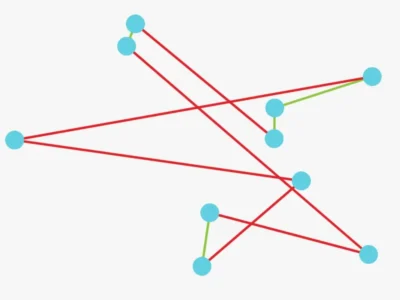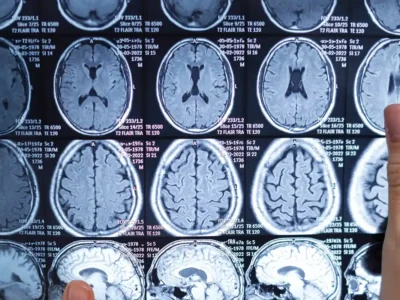In this article we explore in depth the Bipolar Disorder, reviewing its types, causes, symptoms, diagnosis, and treatment.
What is bipolar disorder?
Bipolar disorder, also known as manic depression, is a mental disorder characterized by extreme and abnormal changes in mood, energy, and behavior. This chronic condition alternates between episodes of mania or hypomania and depressive episodes, which can last from days to months.
During a manic episode, the individual may experience an intense feeling of euphoria, high energy levels, impulsivity, and a reduced capacity to make prudent decisions. Conversely, in a depressive episode, the person may feel deeply sad, unmotivated, and lacking energy. These drastic changes affect the ability to lead a normal life, including work, personal relationships, and everyday activities. At times, manic and depressive symptoms can present simultaneously in what is called a “mixed episode“.
In addition to emotional changes, bipolar disorder affects thinking ability, sleep, appetite, and energy. These episodes can be so severe that they significantly disrupt a person’s daily functioning, and in some cases require hospitalization.
Types of bipolar disorder
There are several types of bipolar disorder, which differ in the intensity and duration of manic and depressive episodes. The most common are detailed below:
Bipolar I disorder
This type is characterized by the presence of manic episodes that last at least one week or are so severe that they require immediate hospitalization. Although depressive episodes are also common in bipolar I disorder, they are not necessary for diagnosis. People with this type of disorder may experience mixed episodes, where manic and depressive symptoms occur at the same time.
Bipolar II disorder
Bipolar II disorder involves severe depressive episodes and episodes of hypomania, which are similar to mania but less severe. Hypomania does not cause the social or occupational dysfunction that mania can cause, which often complicates its diagnosis. However, people with bipolar II may experience severe dysfunction due to prolonged depressive episodes, which may include psychotic symptoms.
Cyclothymic disorder
Cyclothymia is a mild form of bipolar disorder, where mood changes do not reach the intensity of major manic or depressive episodes. People with cyclothymia experience mood fluctuations for at least two years in adults, or one year in children and adolescents. Although symptoms are milder, cyclothymia can be debilitating and may develop into major bipolar disorder if not treated.
Unspecified bipolar disorder
This term is used to refer to those bipolar disorders that do not fit perfectly into the categories described. It may include episodes with mixed characteristics or atypical symptoms that do not fully meet the criteria of other subtypes.
Regardless of the type of bipolar disorder, some people experience “rapid cycling”, which means that they have four or more episodes of mania, hypomania, or depression in a single year. Rapid cycling is associated with a more difficult prognosis and a greater need for specialized treatment.
What causes bipolar disorder?
Bipolar disorder is the result of a complex interaction of genetic, neurological, and environmental factors. Although no single cause has been identified, several aspects contribute to its onset:
Genetics
Genetics plays an important role in the development of bipolar disorder. While there is no single gene responsible, studies suggest that the combination of multiple genes may increase the likelihood of developing this condition. Research has shown that having a close relative, such as a parent or sibling, with bipolar disorder significantly increases the risk of developing it. However, inheritance is not determinative; even in identical twins, if one of them has the disorder, the other only has a 40% chance of developing it, which indicates that other factors are also involved.
Environment
Environmental factors such as stress, childhood trauma, troubled relationships, or stressful life events can trigger episodes of bipolar disorder, especially in individuals with a genetic predisposition. Approximately 50% of adults with bipolar disorder have experienced traumatic events in childhood, which can bring forward the onset of the illness and increase the severity of episodes. In addition, lack of sleep or changes in sleep patterns can be a direct trigger for manic episodes.
Neurological condition
Although less common, some neurological conditions can trigger bipolar symptoms. Brain injuries, neurodegenerative diseases such as multiple sclerosis, or even strokes, can affect the areas of the brain related to emotion control and increase the likelihood of developing the disorder.

Subscribe
to our
Newsletter
Symptoms of bipolar disorder
Symptoms of bipolar disorder vary widely, depending on the type of episode the person is experiencing: manic, depressive, or mixed. Below are the characteristics of each phase:
Manic phase
During a manic episode, the person may feel extremely euphoric, energetic, or even irritable. Common symptoms include:
- Increased energy and activity
- Less need for sleep
- Racing thoughts and pressured speech
- Exaggerated self-esteem or grandiosity
- Impulsive or risky behaviors (excessive spending, reckless sexual behavior)
- Difficulty concentrating or making decisions
- In severe cases, psychotic symptoms such as hallucinations or delusions
Depressive phase
A depressive episode is the opposite of mania, and involves deep sadness or hopelessness. Symptoms include:
- Feelings of worthlessness, guilt, or hopelessness
- Loss of interest in activities that used to be pleasurable
- Difficulty concentrating or making decisions
- Changes in appetite and sleep (insomnia or oversleeping)
- Fatigue and lack of energy
- Suicidal thoughts or suicide attempts
Mixed phase
Mixed episodes combine symptoms of both mania and depression at the same time. For example, a person may feel intense sadness along with high energy. This type of episode is highly volatile and can lead to a greater risk of self-harm or suicidal behaviors.
Hypomania
Hypomania is a milder version of mania. Although symptoms are similar, they do not interfere as significantly with daily life, and the person may even feel more productive. However, hypomanic episodes can precede severe depressive episodes.
How is bipolar disorder diagnosed?
Diagnosis of bipolar disorder requires a thorough evaluation by a mental health professional. This process includes:
- Physical examinations: To rule out other possible causes of the symptoms, such as medical problems.
- Clinical history: An analysis of medical and family history to identify genetic risk factors.
- Medical tests: Sometimes blood tests or other tests are performed to rule out other illnesses.
- Mental health assessment: Through clinical interviews and questionnaires to assess the nature and severity of the symptoms.
Treatment of bipolar disorder
Although bipolar disorder is chronic, treatment is essential to help people control symptoms and lead a functional life. The most common treatments include:
- Medications: Mood stabilizers such as lithium, and atypical antipsychotics help control manic and depressive episodes. In some cases, antidepressants may be used under strict supervision.
- Psychotherapy: Therapies, such as cognitive-behavioral therapy, can help people identify negative thought and behavior patterns and develop coping strategies.
- Other treatments: Electroconvulsive therapy (ECT) is an option for severe or treatment-resistant cases. In addition, regular exercise and close monitoring of mood can be useful to prevent relapses.
In some cases, cognitive impairment is an additional aspect of bipolar disorder, especially after multiple episodes. The most affected areas include concentration, memory, and executive functions. To address these problems, cognitive therapy focused on cognitive stimulation can help improve and slow cognitive decline.

Bipolar disorder in society
Impact of Bipolar Disorder on Daily Life
Bipolar disorder not only affects the mental and emotional health of those who suffer from it, but it also has a significant impact on different areas of daily life, such as interpersonal relationships, work, and overall well-being. Understanding these effects is crucial so that both those affected and their loved ones can better manage the challenges posed by this illness.
Interpersonal relationships
People with bipolar disorder often experience difficulties in their family, partner, and friendship relationships. Manic episodes can generate conflicts due to irritability or impulsive behavior, while during depressive episodes isolation or lack of interest in interacting with others is common. These emotional highs and lows can test relationships, generating misunderstandings or tensions.
It is important that close ones understand the nature of the illness, as education about the disorder can facilitate empathy and help establish clear boundaries. Family or couples therapy is useful to improve communication and create a supportive environment.
Work and professional life
Bipolar disorder can significantly affect job performance. During manic episodes, it is common for people to feel excessive confidence and act impulsively, which can lead to imprudent work decisions or risky behaviors. In contrast, depressive episodes can cause work absences, lack of productivity, or difficulty concentrating, which is often perceived as lack of motivation or disinterest in work.
Many affected people face the decision of whether to disclose their condition to their employers. While some prefer to keep it private, others find that sharing their diagnosis facilitates reasonable accommodations in the workplace, such as flexible schedules or reduced workload during acute episodes. In addition, workplace support programs or mental health policies can be valuable resources.
Physical well-being and self-care
Bipolar disorder not only affects mental health, but it may also have consequences for physical health. Changes in sleep, appetite, and energy levels can increase the risk of developing other conditions, such as heart disease or diabetes, especially if there are self-destructive behaviors such as substance abuse.
To maintain good physical and mental health, it is essential that people with bipolar disorder follow a healthy lifestyle, which includes:
- Regular sleep routines: Sleep is a key factor in preventing manic episodes, so it is vital to maintain a stable sleep routine.
- Regular exercise: Physical activity can improve mood and reduce stress.
- Balanced nutrition: Eating healthily helps maintain energy levels and regulate mood.
- Avoid alcohol and drugs: Substances can trigger manic or depressive episodes and complicate treatment.
Conclusion
Bipolar disorder is a chronic condition that affects all areas of life for those who suffer from it. From interpersonal relationships to job performance and physical health, the impact is broad. However, with proper diagnosis and ongoing treatment, many people with bipolar disorder can lead a full and productive life. Understanding, patience, and social support are key to helping manage the effects of this illness.
If you liked this post about the bipolar disorder, you might also be interested in other NeuronUP publications:
“This article has been translated. Link to the original article in Spanish:”
Trastorno bipolar: qué es, tipos, causa, síntomas, diagnóstico y tratamiento







 The neuropsychological clinic: what it is, methodology, and objectives
The neuropsychological clinic: what it is, methodology, and objectives
Leave a Reply